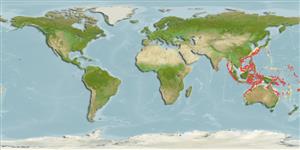>
Zeiformes (Dories) >
Parazenidae (Parazen) > Cyttopsinae
Etymology: Cyttopsis: Greek, kyttaros, kytos = a convex cavity + Greek, opsis = appearance.
More on author: Fowler.
Environment: milieu / climate zone / depth range / distribution range
Ecologia
marino benthopelagico. Tropical
Western Pacific: southeast Asia and the northern Australia.
Size / Peso / Age
Maturity: Lm ? range ? - ? cm
Max length : 7.8 cm SL maschio/sesso non determinato; (Ref. 5978)
Occurs on the continental shelf and continental slope. Benthic species (Ref. 75154).
Life cycle and mating behavior
Maturità | Riproduzione | Deposizione | Uova | Fecundity | Larve
Kailola, P.J., 1987. The fishes of Papua New Guinea. A revised and annotated checklist. Vol. 1. Myxinidae to Synbranchidae. Research Bulletin No. 41. Department of Fisheries and Marine Resources, Port Moresby, Papua New Guinea. 194 p. (Ref. 6993)
IUCN Red List Status (Ref. 130435: Version 2024-1)
Threat to humans
Harmless
Human uses
Strumenti
Special reports
Download XML
Fonti Internet
Estimates based on models
Preferred temperature (Ref.
123201): 11.6 - 21.8, mean 15.9 °C (based on 235 cells).
Phylogenetic diversity index (Ref.
82804): PD
50 = 0.8125 [Uniqueness, from 0.5 = low to 2.0 = high].
Bayesian length-weight: a=0.01738 (0.00668 - 0.04524), b=3.00 (2.78 - 3.22), in cm total length, based on LWR estimates for this (Sub)family-body shape (Ref.
93245).
Trophic level (Ref.
69278): 3.4 ±0.8 se; based on size and trophs of closest relatives
Fishing Vulnerability (Ref.
59153): Low vulnerability (10 of 100).
